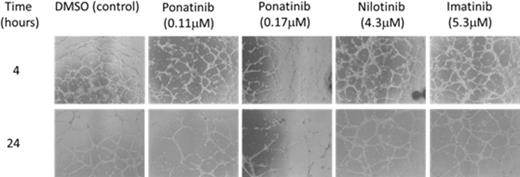Abstract
The introduction of several tyrosine kinase inhibitors (TKIs) into the armamentarium of chronic myeloid leukemia (CML) treatment has revolutionized the prognosis of this disease, changing it from a fatal one into a potentially curable disease. Five TKIs are now in clinical use: imatinib, nilotinib, dasatinib, bosutinib and ponatinib. This allows the clinician the privilege to personalize treatment based on the toxicity profile of the various TKIs, taking into account patients' comorbidities and lifestyle. Although side effects are common to all TKIs, each one has its unique safety profile. Consequently, one of the main challenges in the contemporary management and research of CML is the understanding and control of TKI-associated adverse events. TKI-associated vascular disease is amongst the most perturbing and poorly understood of these adverse events. Nilotinib is probably associated with an increased risk of arterial vascular events, especially peripheral artery occlusive disease (PAOD) compared with imatinib. Conversely, the notorious effect of nilotinib on PAOD, manifested in comparative clinical trials, might be attributed to a protective effect of imatinib. Similar data has started to emerge regarding ponatinib, including fatal cerebrovascular events, ranging from 20-42% of patients. These side effects of ponatinib occur after as little as 8 months of treatment. The mechanism of this increased tendency for vascular events associated with specific TKIs, remains incompletely understood, and there has been only limited research exploring the possible pathophysiological mechanisms involved. We therefore initiated a preclinical in vitro study in order to ascertain a potential molecular mechanism responsible for these adverse vascular events. Specifically, we studied the effect of nilotinib and ponatinib on human umbilical vein endothelial cells (HUVEC) in comparison to that of imatinib. When examining pharmacologically relevant concentrations (5.3µM imatinib, 4.3µM nilotinib and 0.11µM or 0.17µM ponatinib), annexin/PI staining showed that following a 24 hour exposure period, imatinib, nilotinib and ponatinib did not lead to an increase in apoptosis (DMSO (control): 8.8%±2.4; imatinib: 13.2%±1.2; nilotinib: 9.6%±0.6; ponatinib 11.1%±1.8, p-value not statistically significant). However, under these same conditions, ponatinib dramatically inhibited angiogenesis of HUVECs in a tube-formation assay. This inhibition was evident even when exposing the cells to the lower physiological concentrations of the drug (0.11µM). Relative average tube area (calculated relative to control) was as follows: DMSO (control): 1; imatinib: 0.86±0.3; nilotinib: 1±0.5; 0.11µM ponatinib (equivalent to 30mg/day): 0.4±0.1 p-value<0.05; 0.17µM ponatinib (equivalent to 45mg/day): 0.37±0.1 p-value<0.05 (Fig. 1). First signs of reduction in average tube area following ponatinib treatment were detected as early as 4 hours post exposure to the drug. This type of early effect suggests that ponatinib might inhibit initial tube formation rather than cause the tubes to dissociate after they have been formed. These results indicate that ponatinib exerts a suppressive effect on neo-angiogenesis of vascular endothelial cells. Angiogenesis is characterized by the appearance of capillarized vascular structures through enhanced expression of pro-angiogenic factors, such as VEGFR and FGFR. To the best of our knowledge, this is the first report regarding ponatinib's impact on angiogenesis in vitro. Since the suppressive effect of ponatinib on angiogenesis of HUVECs was not a result of apoptosis, it might be mediated through VEGFR or FGFR, as both are ponatinib's off-targets. An understanding of the pathophysiology of the vascular events may help guide monitoring, allowing for earlier interventions and management of vascular risk factors. In addition, it will contribute to the identification of potential targets for intervention and/or prevention in a significant minority of patients who have no other treatment options and ensure that researchers developing next generation TKIs avoid targeting the same pathways.
Ponatinib inhibits HUVEC tube formation. HUVECs were plated on Matrigel-coated plates in presence of DMSO, ponatinib, nilotinib or imatinib. Tube formation was evaluated after 4 and 24 h by light microscope. Representative fields (ª4 magnification) are pictured.
Ponatinib inhibits HUVEC tube formation. HUVECs were plated on Matrigel-coated plates in presence of DMSO, ponatinib, nilotinib or imatinib. Tube formation was evaluated after 4 and 24 h by light microscope. Representative fields (ª4 magnification) are pictured.
Raanani:Novartis: Consultancy, Research Funding; Pfizer: Consultancy; Ariad: Consultancy, Research Funding; BMS: Consultancy. Leader:Novartis: Research Funding.
Author notes
Asterisk with author names denotes non-ASH members.


